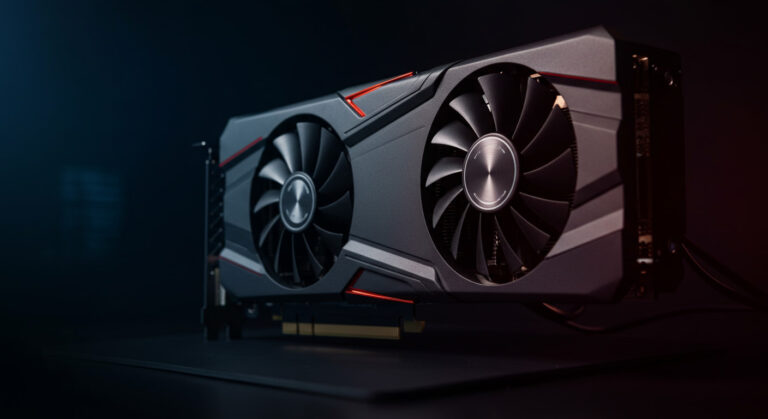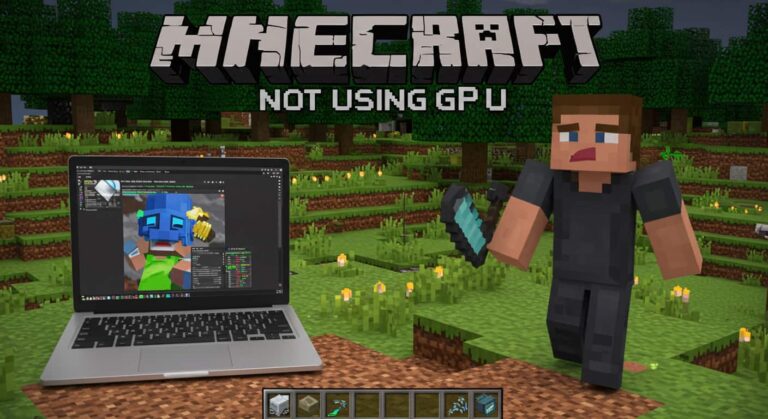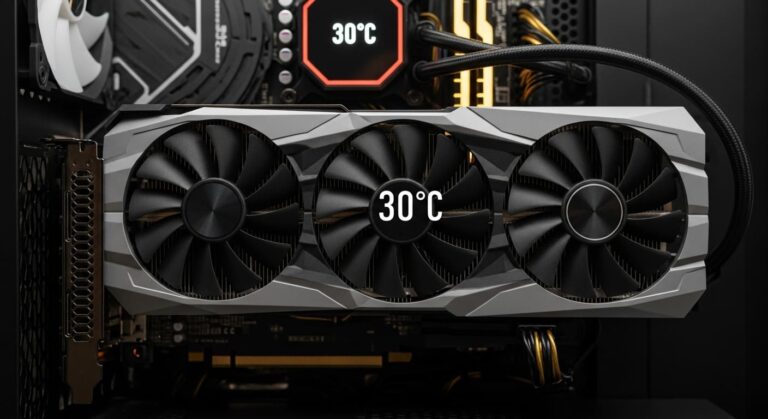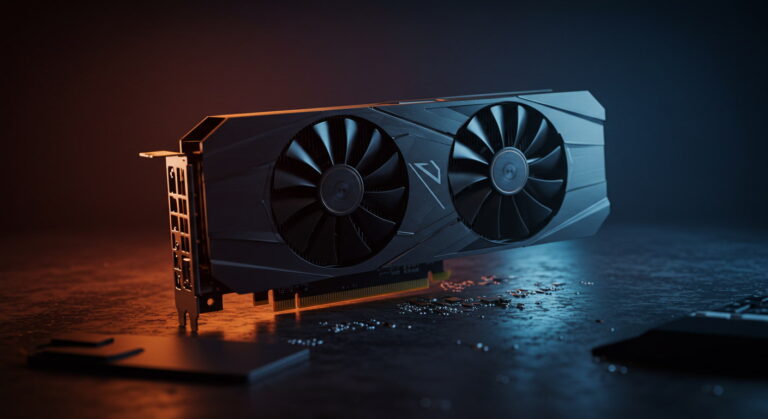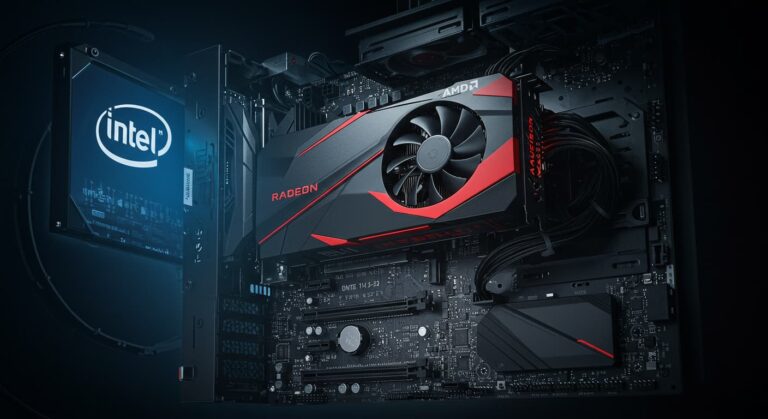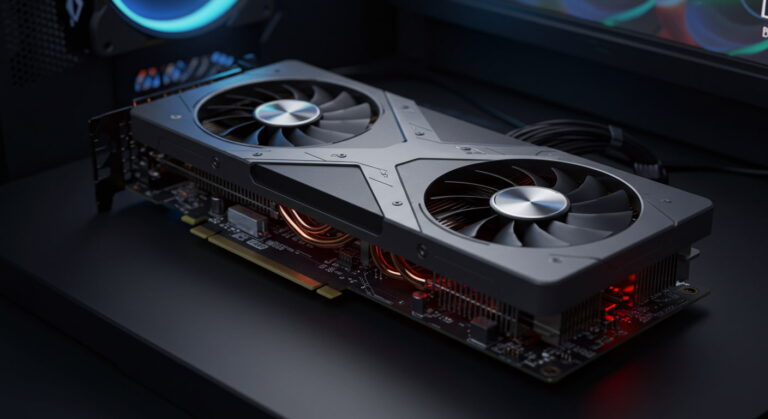Is 70 GPU Temp Bad – Complete Guide to Safe GPU Temperatures!
Many gamers and PC users often ask, “Is 70 GPU temp bad?” The truth is that GPU temperature depends on what you are doing and how your cooling system performs. A temperature around 70°C is generally considered safe for most modern GPUs. This guide explains everything you need to know about GPU temperatures, safe ranges, and how to keep your system healthy.
Understanding GPU Temperature Basics
What Is a Normal GPU Temperature Range?
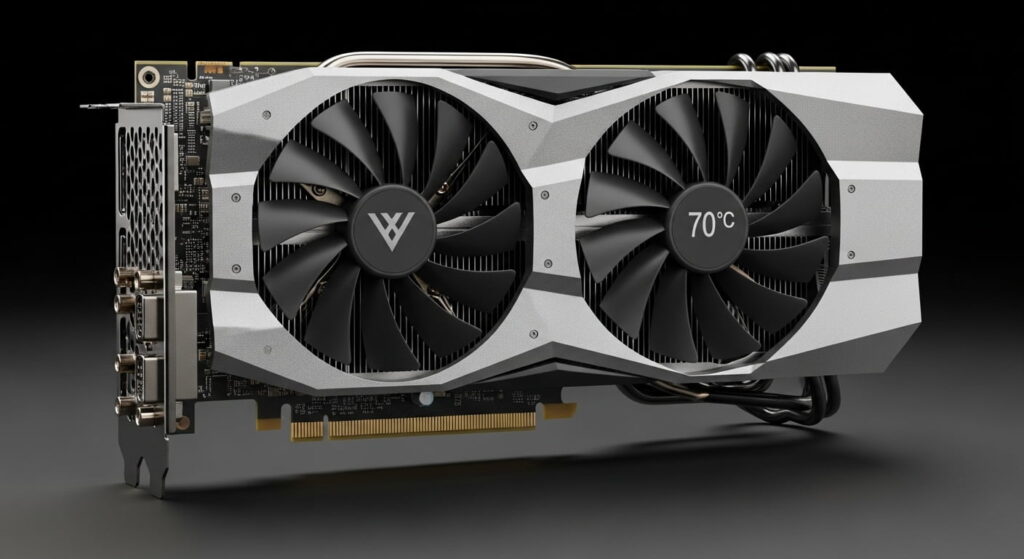
A normal GPU temperature range depends on the model and workload. For most graphics cards, 40°C–60°C is normal when idle, and 65°C–85°C is typical when gaming or rendering. Modern GPUs can even handle up to 90°C safely, though it’s best to stay below 80°C for long-term use. Each GPU has a designed temperature limit known as the “Tjunction,” and 70°C falls well below this. So, a reading of 70°C means your GPU is functioning properly under stress.
Why GPU Temperature Matters for Performance and Longevity
GPU temperature directly affects how your system performs and how long your graphics card lasts. High temperatures can cause thermal throttling, which lowers GPU clock speeds to prevent overheating. This can reduce performance in games or rendering tasks. Consistently high heat can also damage thermal paste and affect fan efficiency. Keeping your GPU cool ensures stable performance and extends its lifespan. Balanced temperature management keeps your gaming and creative work smooth.
How GPU Cooling Systems Work
A GPU cooling system removes heat produced by the graphics processor. Most GPUs use a combination of fans and heatsinks. The fans pull in cool air while the heatsink spreads the heat away from the GPU chip. Some high-end cards use liquid or vapor chamber cooling to handle heavy loads. If airflow is blocked by dust or poor case design, temperatures rise quickly. A well-maintained cooling system keeps the GPU running at safe levels like 70°C or below.
Is 70 Degrees Too Hot for a GPU?
What Happens When GPU Hits 70°C
When your GPU reaches 70°C, it’s performing within the normal range. The card’s fans adjust automatically to maintain this level. This temperature indicates that your GPU is working efficiently during games or rendering. You don’t need to worry unless it continues to climb above 85°C for long periods. A steady 70°C means your cooling system is functioning as expected and keeping performance stable.
Comparing Safe GPU Temps Across Different Models
Different GPU models have different safe temperature limits. For example, NVIDIA’s RTX cards typically run safely up to 85°C, while AMD GPUs can handle up to 90°C. Laptops may run hotter due to limited airflow, while desktop GPUs stay cooler with better ventilation. So, if your card stays at 70°C, you are well within a safe range no matter the brand or type of system.
Also read: How Good Is 30c GPU Temp On Idle
Is 70°C Dangerous for Modern GPUs?
No, 70°C is not dangerous for modern GPUs. It’s actually a sign that your GPU is performing properly under load. Manufacturers like NVIDIA and AMD design GPUs to operate safely up to much higher temperatures. Only when you consistently hit above 90°C should you be concerned. Therefore, 70°C is a comfortable temperature for gaming, video editing, or other GPU-intensive tasks.
Is 70°C While Gaming OK?
Typical GPU Temps During Gaming
While gaming, most GPUs operate between 65°C and 80°C depending on the game’s graphics demands. If your GPU reaches 70°C, that’s completely fine and even ideal for gaming. High-end GPUs naturally heat up as they process millions of frames per second. 70°C means your cooling is effective, and your GPU is running efficiently without thermal throttling.
How Game Intensity Affects GPU Heat
The intensity of a game determines how hard your GPU works. Heavy games with advanced graphics like Cyberpunk 2077 or Red Dead Redemption 2 push GPUs harder, leading to higher temperatures. Lighter games like Valorant or Minecraft keep temperatures lower. Settings like resolution, ray tracing, and frame rate also impact GPU heat. Adjusting these can help maintain a comfortable 70°C range during play.
Ideal Gaming Temperature Range
For most gaming PCs, the ideal GPU temperature range is between 60°C and 75°C. This range offers the best balance between performance and safety. 70°C fits perfectly in the middle, meaning your GPU is healthy. If temperatures stay steady without frequent spikes above 85°C, your system is performing perfectly.
Is 67–70°C a Good GPU Temperature on 100% Usage?
What Full Load Means for Your GPU
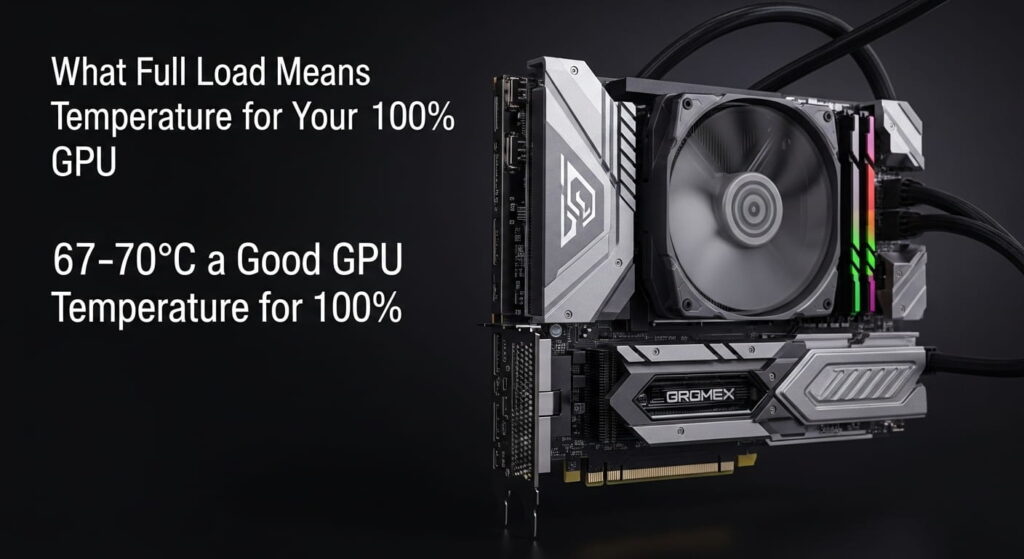
Full load means your GPU is being used at 100% capacity. This happens during intense gaming, rendering, or video editing. When a GPU is at full load and the temperature stays around 67–70°C, that’s an excellent result. It shows that your cooling system is strong, and your GPU is running efficiently under pressure.
Safe Temperature Range Under Maximum Load
Under maximum load, GPUs can safely run up to 85°C without any issues. However, keeping them between 65°C and 75°C is ideal for long-term reliability. So, if your GPU runs between 67°C and 70°C, it’s operating in an optimal zone. This temperature range ensures full performance without throttling or hardware stress.
How to Monitor GPU Temps in Real-Time
Monitoring GPU temperature is easy with tools like MSI Afterburner, HWMonitor, or GPU-Z. These programs show real-time readings for temperature, fan speed, and GPU usage. You can also enable on-screen displays while gaming. Keeping track of these numbers helps prevent overheating and ensures your GPU stays safely around 70°C.
Is 70°C a Good Temperature for a GPU While Playing Games?
Why 70°C Is Often Considered Normal
70°C is widely considered a normal temperature while gaming. It’s high enough to show that the GPU is working but low enough to avoid overheating. Gamers and professionals agree that 70°C is the sweet spot for performance and cooling efficiency.
Factors That Affect GPU Temperature While Gaming
Many factors can influence GPU temperature, including room temperature, airflow, case design, and dust buildup. Overclocking and long gaming sessions also raise temperatures. To maintain around 70°C, ensure your case has clean airflow, proper fan curves, and no dust blocking the vents.
When to Start Worrying
You should only start worrying if your GPU consistently runs above 85°C for long periods. At 70°C, there’s absolutely no danger. If you notice temperatures rising unexpectedly, clean your fans and check for background software using GPU resources.
Also read: Average GPU Temp While Gaming
Is 70 GPU Temp Bad for Different Devices and Uses?
Is 70 GPU Temp Bad for Gaming?
No, it’s not. 70°C is actually perfect for gaming. Most modern GPUs are designed to run safely between 65°C and 85°C when under heavy load. During gaming, your GPU is working hard to process complex graphics and frame rates, so temperatures naturally rise.
At 70°C, your GPU is performing efficiently without reaching the danger zone. This temperature shows that your cooling system and airflow are doing their job. Unless it crosses 85°C, you don’t need to worry. For long gaming sessions, 70°C means your GPU is comfortable and stable — providing you with smooth gameplay and top performance.
Is 70 GPU Temp Bad for PC?
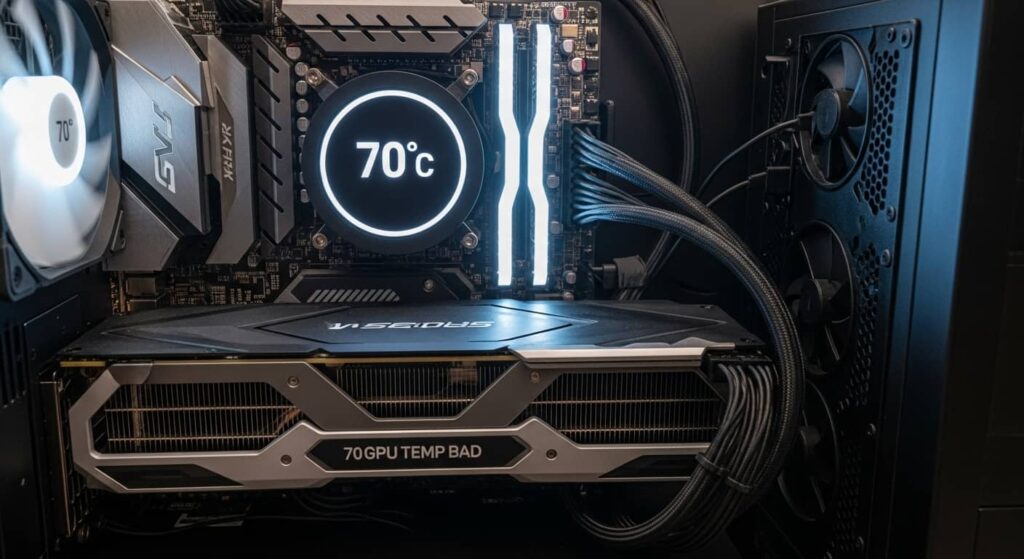
For desktop PCs, 70°C is completely safe and normal. Desktop systems usually have larger cases, better airflow, and stronger fans than laptops, which helps maintain stable temperatures.
If your GPU stays at 70°C during gaming, streaming, or rendering, it means your setup is working well.
You can even consider 70°C as an ideal temperature for a desktop GPU under load. Just make sure your case isn’t clogged with dust and your fans spin correctly.
A well-maintained desktop PC will easily handle 70°C without any risk to performance or hardware health.
Is 70 GPU Temp Bad for Laptops?
For laptops, 70°C is not just safe — it’s excellent. Laptops tend to run hotter because of their compact design and limited airflow. Many gaming laptops reach up to 80–90°C during demanding games.
If your laptop GPU stays at 70°C while gaming or editing videos, it’s a sign of great cooling efficiency.
To maintain this temperature, use your laptop on a flat surface, clean the vents regularly, and consider using a cooling pad to improve air circulation.
Running at 70°C in a laptop means your cooling system is doing a great job under pressure.
Is 70 GPU Temp Bad for Long Gaming Sessions?
Even during long gaming sessions, 70°C is completely safe. Modern GPUs are built to handle continuous use at high temperatures.
If your GPU maintains a steady 70°C after hours of gaming, that’s actually a good sign. It means the card is stable, and your system has effective thermal control.
Problems only arise if the temperature continues to rise above 85°C–90°C for extended periods.
To keep things consistent, ensure your case fans are clean, your power supply is stable, and your GPU has enough breathing space. Consistency is key — a steady 70°C for hours is perfectly fine.
Is 70 GPU Temp Bad for Desktop PCs?
In desktop PCs, a 70°C reading during gaming or rendering is absolutely normal. Desktop GPUs are designed to operate efficiently within this range.
If your system is clean, has proper cable management, and uses quality thermal paste, it will easily maintain 70°C under heavy load.
Some high-performance GPUs, like the NVIDIA RTX 4080 or AMD RX 7900 XT, even consider 70°C as cool during intense gaming.
As long as your temperature doesn’t climb near 85°C, your desktop PC’s GPU is in perfect health.
Brand-Specific GPU Temperature Safety
Is 70 GPU Temp Bad for Nvidia Cards?
For NVIDIA GPUs, 70°C is excellent and well within the safe zone. Most NVIDIA cards, such as the RTX 3060, 4070, or GTX 1080, can safely run up to 83°C–85°C before any performance throttling happens.
At 70°C, your card is cool, efficient, and performing at full capacity. NVIDIA’s built-in fan control systems automatically manage speed to maintain these levels.
Many gamers even report that their NVIDIA cards rarely drop below 70°C when gaming at 1440p or 4K resolution — so it’s completely normal.
Also read: Ideal GPU Temp While Gaming
Is 70 GPU Temp Bad for AMD GPUs?
AMD GPUs are built to handle higher temperatures compared to most NVIDIA cards. Cards like the RX 6800 XT or RX 7900 XTX can operate safely up to 90°C–95°C.
That means 70°C for an AMD GPU is far from bad — it’s actually on the cooler side. AMD uses a feature called “Junction Temperature” which measures the hottest part of the GPU die. Even if that number reads around 90°C, your average GPU temp (like 70°C) is very healthy.
So yes, 70°C for an AMD GPU is completely fine and even desirable.
GPU Temperature in Special Scenarios
Is 70 GPU Temp Bad When Idle?
Yes, 70°C is high when your system is idle. When your computer isn’t running games or heavy programs, your GPU should stay between 35°C and 50°C.
If you see 70°C when idle, something may be running in the background — like a hidden browser tab, mining software, or a stuck process.
Also, check your fans and thermal paste, as poor cooling can cause idle temperatures to rise. Once you fix the airflow or close background apps, your idle temperature should drop back to normal.
Is 70 GPU Temp Bad for Streaming or Rendering?
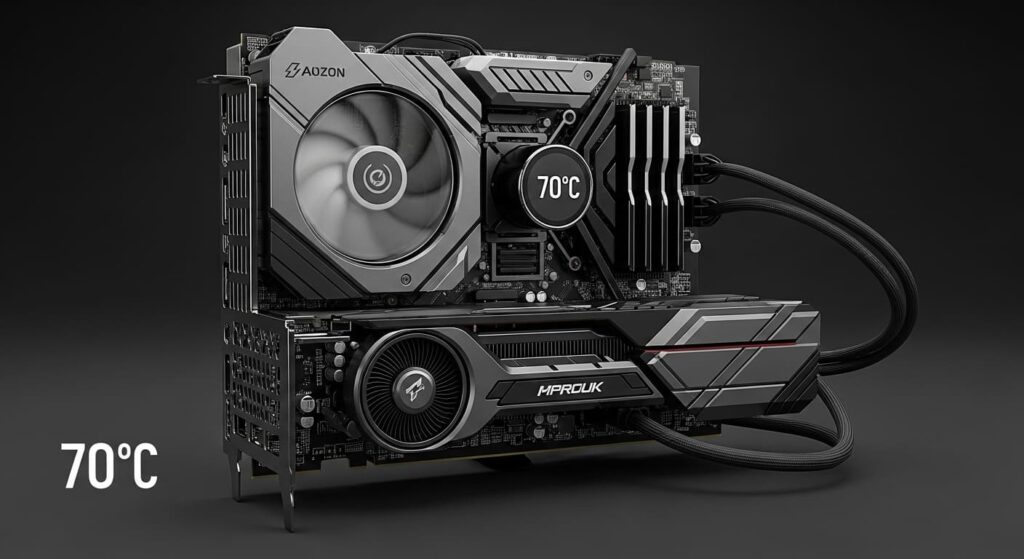
No, 70°C is safe for streaming or rendering. These tasks use the GPU heavily, sometimes even more than gaming.
When you stream gameplay or render videos, your GPU is under constant load. A stable temperature of 70°C means your GPU is performing well under pressure.
Many professional streamers and video editors report similar temperatures during long sessions, so there’s no need for concern unless it climbs past 85°C.
Is 70 GPU Temp Bad in Summer or Hot Environments?
In summer or hot rooms, 70°C is very acceptable. High ambient temperatures naturally raise GPU heat since the air used for cooling is already warm.
If your room temperature is around 30°C or higher, your GPU will naturally run a few degrees hotter.
Make sure your PC has enough airflow, and consider using an air conditioner or external fan to help your system breathe better. As long as the GPU doesn’t cross 85°C, it’s safe even in warm weather.
Is 70 GPU Temp Bad Without Cooling Fans?
Without working fans, 70°C can quickly rise higher, especially under load. If your GPU fans aren’t spinning, it could reach unsafe temperatures fast.
Always check that your GPU fans spin when under load — most modern cards have a “fan stop” mode where they turn off below 50°C to reduce noise.
However, during gaming, fans must run. Running your GPU without fans during heavy use can lead to overheating and damage, so regular fan maintenance is essential.
Is 70 GPU Temp Bad for Overclocked GPUs?
For overclocked GPUs, 70°C is actually very good. Overclocking increases power consumption and heat output, so seeing a stable 70°C means your cooling setup is solid.
Many overclocked cards can reach up to 80°C or more during benchmarks, so keeping it around 70°C ensures both stability and performance.
Just make sure your power limit and voltage settings are within safe boundaries, and you’ll have no issues.
Is 70 GPU Temp Bad in the BIOS or Startup?
If your GPU shows 70°C in the BIOS or right after startup, that’s slightly higher than normal.
At startup, the GPU isn’t under load, so it should ideally be between 40°C and 55°C.
If it’s at 70°C, your fans might not be spinning yet, or dust could be blocking airflow. Once your system boots and the fans start, the temperature should drop within a few minutes.
If not, check your fan curves and ensure the cooling system is working properly.
Also read: GPU Compatibility with Motherboard
Is 70 GPU Temp Bad for VR Gaming?
VR gaming pushes the GPU harder than regular gaming because it has to render two screens at high frame rates.
Even then, 70°C is perfectly safe. It means your GPU is performing well under the heavy VR workload.
Games like Beat Saber, Half-Life: Alyx, or No Man’s Sky VR can push GPUs to their limits, but 70°C is still within the optimal range.
Is 70 GPU Temp Bad While Using Ray Tracing?
Ray tracing uses advanced lighting and shadow calculations that heavily load the GPU.
Despite the added stress, 70°C is completely safe while ray tracing.
It shows that your GPU’s thermal system is handling the added workload efficiently. Even with ray tracing enabled in games like Cyberpunk 2077 or Control, 70°C is an excellent temperature to maintain.
FAQs About GPU Temperatures
1: What is the ideal temperature for gaming GPUs?
Between 60°C and 75°C is ideal for gaming.
2: Is 70°C considered high for idle GPUs?
Yes, idle GPUs should stay between 35°C and 50°C.
3: Can 70°C damage a GPU over time?
No, 70°C is completely safe and normal.
4: How can I reduce GPU temperature while gaming?
Improve airflow, clean fans, and use quality cooling.
5: Do laptop GPUs heat up faster than desktop GPUs?
Yes, laptops have limited cooling, so they run hotter.
6: Is it safe to overclock at 70°C?
Yes, if the temperature remains stable under load.
7: What are the signs my GPU is overheating?
Lag, fan noise, or crashes are common signs.
8: Can room temperature affect GPU performance?
Yes, hot rooms can raise GPU temps slightly.
9: Should I worry about GPU temps when streaming?
No, 70°C during streaming is completely safe.
10: What tools can monitor GPU temperature?
MSI Afterburner, HWMonitor, and GPU-Z are great options.
Final Verdict — Is 70 GPU Temp Really Bad?
Quick Summary of Safe GPU Temps
In short, 70°C is not bad for a GPU — it’s actually a healthy and safe temperature for most gaming, rendering, and daily tasks. Modern GPUs are designed to handle temperatures between 65°C and 85°C comfortably. If your GPU stays around 70°C during load, that means your cooling system, thermal paste, and airflow are working efficiently. Only when temperatures go beyond 85°C–90°C should you start paying attention.
When You Should Take Action
You only need to worry if your GPU stays at 70°C while idle or keeps climbing higher during use. In such cases, check for dust buildup, fan issues, or high room temperature. Make sure your drivers are updated and that your system’s ventilation is clear. Adding extra case fans or using a cooling pad for laptops can make a big difference.
Best Practices for Long-Term GPU Performance
To keep your GPU running smoothly for years, maintain good airflow, clean your fans regularly, and replace thermal paste every couple of years. Avoid overclocking too aggressively and monitor your GPU temperature using tools like MSI Afterburner or HWMonitor.
If your GPU runs at 70°C during gaming, streaming, or rendering, you’re in the perfect temperature zone — safe, efficient, and worry-free.
Related post:

